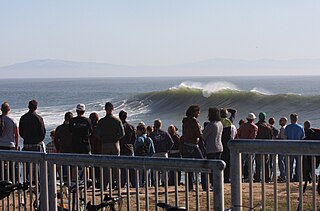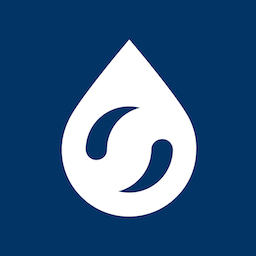
Surfing is a surface water sport in which an individual, a surfer, uses a board to ride on the forward section, or face, of a moving wave of water, which usually carries the surfer towards the shore. Waves suitable for surfing are primarily found on ocean shores, but can also be found in standing waves in the open ocean, in lakes, in rivers in the form of a tidal bore, or in wave pools.

Big wave surfing is a discipline within surfing in which experienced surfers paddle into, or are towed into, waves which are at least 20 feet high, on surf boards known as "guns" or towboards. Sizes of the board needed to successfully surf these waves vary by the size of the wave as well as the technique the surfer uses to reach the wave. A larger, longer board allows a rider to paddle fast enough to catch the wave and has the advantage of being more stable, but it also limits maneuverability and surfing speed.

A breakwater is a permanent structure constructed at a coastal area to protect against tides, currents, waves, and storm surges. Part of a coastal management system, breakwaters are installed to minimize erosion, and to protect anchorages, helping isolate vessels within them from marine hazards such as prop washes and wind-driven waves. A breakwater, also known in some contexts as a jetty, may be connected to land or freestanding, and may contain a walkway or road for vehicle access.

An artificial reef is a human-created underwater structure, typically built to promote marine life in areas with a generally featureless bottom, to control erosion, block ship passage, block the use of trawling nets, or improve surfing.

Santa Monica Bay is a bight of the Pacific Ocean in Southern California, United States. Its boundaries are slightly ambiguous, but it is generally considered to be the part of the Pacific within an imaginary line drawn between Point Dume, in Malibu, and the Palos Verdes Peninsula. Its eastern shore forms the western boundary of the Los Angeles Westside and South Bay regions. Although it was fed by the Los Angeles River until the river's catastrophic change of course in 1825, the only stream of any size now flowing into it is Ballona Creek. Smaller waterways draining into the bay include Malibu Creek, Topanga Creek, and Santa Monica Creek.

George Hamilton Perkins Greenough is an influential surfer known during the 1960s and 1970s for his designs and work in film, board design, fin characteristics, and other creations for the aquatic medium. Greenough's and McTavish's contributions to developing the shortboards resulted in a wave of new advancements in surfing technology and shapes used to design boards.

The Banzai Pipeline, or simply Pipeline or Pipe, is a surf reef break located in Hawaii, off Ehukai Beach Park in Pupukea on O'ahu's North Shore. A reef break is an area in the ocean where waves start to break once they reach the shallows of a reef. Pipeline is known for huge waves that break in shallow water just above a sharp and cavernous reef, forming large, hollow, thick curls of water that surfers can tube ride. There are three reefs at Pipeline in progressively deeper water farther out to sea that activate according to the increasing size of approaching ocean swells.

Shaun Tomson is a South African professional surfer and former world champion, environmentalist, actor, author, and businessman. He has been listed among the top 10 surfers of the century, and was the 1977 World Surfing Champion.

Surf culture includes the people, language, fashion, and lifestyle surrounding the sport of surfing. The history of surfing began with the ancient Polynesians. That initial culture directly influenced modern surfing, which began to flourish and evolve in the early 20th century, with its popularity peaking during the 1950s and 1960s. It has affected music, fashion, literature, film, art, and youth jargon in popular culture. The number of surfers throughout the world continues to increase as the culture spreads.

The Surfrider Foundation USA is a U.S. 501(c)(3) grassroots non-profit environmental organization that works to protect and preserve the world's oceans, waves and beaches. It focuses on water quality, beach access, beach and surf spot preservation, and sustaining marine and coastal ecosystems.
Surf forecasting is the process of using offshore swell data to predict onshore wave conditions. It is used by millions of people across the world, including professionals who put their forecasts online, meteorologists who work for news crews, and surfers all over the world. It is impossible to make an exact prediction of the surf, but by knowing a few factors a good prediction can be made. One needs to have an understanding of how waves are formed, a basic knowledge of bathymetry, and information about the surf spot being forecasted to accurately forecast the surf.

Steamer Lane is a famous surfing location in Santa Cruz, California. It is just off a point on the side of cliffs in the West Cliff residential area near downtown Santa Cruz, providing easy access and a good vantage point for viewing. The Santa Cruz Surfing Museum is housed in a lighthouse there. "Steamer Lane" is the preferred form of the name used by the people surfing there. Steamer Lane was named by Claude Horan while he was a student at San Jose State in the late 1930s. One flat calm day he and his friend Wes Hammond thought it would be a good idea to hire steamships to cruise back and forth to generate waves for surfing. It was at Steamer Lane that the modern surfing wetsuit and the leash were mainly developed by Jack O'Neill, who had his surf shop nearby for many years.
International Surfing Day, held annually on the third Saturday of June, is an unofficial, environmentally conscious sports-centered holiday that celebrates the sport of surfing, surfing lifestyle, and the sustainability of ocean resources. Contests and prizes are also part of the celebration, with surfing-related industries donating prizes such as surfboards and wetsuits. Another purpose of the celebration is to promote the popularity of surfing and to attract new participants.

A surf break is a permanent obstruction such as a coral reef, rock, shoal, or headland that causes a wave to break, forming a barreling wave or other wave that can be surfed, before it eventually collapses. The topography of the seabed determines the shape of the wave and type of break. Since shoals can change size and location, affecting the break, it takes commitment and skill to find good breaks. Some surf breaks are quite dangerous, since the surfer can collide with a reef or rocks below the water.
A multi-purpose reef, also commonly known as an artificial surfing reef or surf reef, is a structure located offshore designed to induce wave breaking in a manner that creates a wave suitable for surfing or body boarding. Artificial surfing reefs can exist in many different configurations and be built from a variety of different materials. To date there have been fewer than ten attempts worldwide to build such structures.

Boscombe Surf Reef was an artificial reef built to enhance surfing conditions at Boscombe in Dorset, England.
Swami’s State Marine Conservation Area (SMCA) is a marine protected area that extends offshore of Encinitas in San Diego County on California’s south coast. The SMCA covers 12.65 square miles. The SMCA protects marine life by limiting the removal of marine wildlife from within its borders.

Surfline is a company and website based in Huntington Beach, California that specializes in surf forecasting and surf reports, live webcasting, photography, videography, as well as editorial coverage of the sport of surfing. Surfline.com is now ranked 1,180 in the US and 5,784 in the world in terms of popularity compared to other websites and is now the largest provider of streaming HD coastal cams. Since 2003 it has taken on buoyweather.com and fishtrack.com (2012), on average the family of websites receives 175,000 visitors per day. The site includes streaming video, surf reports and forecasts. Surfline.com offers streaming cameras at 150 surf breaks, and is one of the larger surf cam websites. Surfline currently has approximately 50 employees.
Ruggles is an East Coast surf break Located in Rhode Island. The rocky reef break features three distinct breaks: "The Point" "Out Front" and "Around the Corner", each of which presents different challenges, and becomes active during different weather patterns.

Uluwatu is a region on the south-western tip of the Bukit Peninsula of Bali, Indonesia. It is home to the Pura Luhur Uluwatu Temple.


















